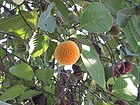Note: This is a project under development. The articles on this wiki are just being initiated and broadly incomplete. You can Help creating new pages.
Difference between revisions of "Anthocephalus cadamba - Kadamba, Wild cinchona"
(→Commonly seen growing in areas) |
(→Commonly seen growing in areas) |
||
| Line 55: | Line 55: | ||
==Commonly seen growing in areas== | ==Commonly seen growing in areas== | ||
| − | {{Commonly seen|Trophical area}}, {{Commonly seen|Sub | + | {{Commonly seen|Trophical area}}, {{Commonly seen|Sub trophical area}}. |
==Photo Gallery== | ==Photo Gallery== | ||
Revision as of 17:31, 13 December 2018
Wild cinchona or Kadamba scientifically known as Neolamarckia cadamba is a large, evergreen tree with beautiful & unique flowers. It is a fast growing tree with a broad crown and is even planted sacredly near temples.
Contents
- 1 Uses
- 2 Parts Used
- 3 Chemical Composition
- 4 Common names
- 5 Properties
- 6 Habit
- 7 Identification
- 8 List of Ayurvedic medicine in which the herb is used
- 9 Where to get the saplings
- 10 Mode of Propagation
- 11 How to plant/cultivate
- 12 Commonly seen growing in areas
- 13 Photo Gallery
- 14 References
- 15 External Links
Uses
Diabetes, Cancer, Fungal infections, Musculo-skeletal diseases, High cholesterol, Triglycerides, Parasitic infection, Digestive disturbances.
Parts Used
Chemical Composition
The preliminary phytochemical screening of Anthocephalus cadamba whole plant showed the presence of saponins, terpenes, sesquiterpenes glycosides, alkaloids and absence of anthraquinones and flavonoids. A variety of phytoconstituents, such as cadambine, cadamine, β-sitosterol, quinovic acid, chlorogenic acid[1]
Common names
| Language | Common name |
|---|---|
| Kannada | |
| Hindi | |
| Malayalam | |
| Tamil | |
| Telugu | |
| Marathi | |
| Gujarathi | |
| Punjabi | |
| Kashmiri | |
| Sanskrit | |
| English |
Properties
Reference: Dravya - Substance, Rasa - Taste, Guna - Qualities, Veerya - Potency, Vipaka - Post-digesion effect, Karma - Pharmacological activity, Prabhava - Therepeutics.
Dravya
Rasa
Tikta (Bitter), Kashaya (Astringent)
Guna
Veerya
Vipaka
Karma
Prabhava
Habit
Identification
Leaf
| Kind | Shape | Feature |
|---|---|---|
| Paripinnate | Oblong | Leaf Arrangementis Alternate-spiral |
Flower
| Type | Size | Color and composition | Stamen | More information |
|---|---|---|---|---|
| Unisexual | 2-4cm long | pink | Flowering throughout the year and In terminal and/or axillary pseudoracemes |
Fruit
| Type | Size | Mass | Appearance | Seeds | More information |
|---|---|---|---|---|---|
| oblong pod | Thinly septate, pilose, wrinkled | seeds upto 5 | Fruiting throughout the year |
Other features
List of Ayurvedic medicine in which the herb is used
Where to get the saplings
Mode of Propagation
How to plant/cultivate
Kadamba is a deciduous tree which grows throughout India, especially in low lying areas and wet regions. They need full Sun to partial shade and the temperature varies up to 20’ – 40’ Celsius.[3]
Commonly seen growing in areas
Trophical area, Sub trophical area.
Photo Gallery
References
External Links
- Ayurvedic Herbs known to be helpful to treat Diabetes
- Ayurvedic Herbs known to be helpful to treat Cancer
- Ayurvedic Herbs known to be helpful to treat Fungal infections
- Ayurvedic Herbs known to be helpful to treat Musculo-skeletal diseases
- Ayurvedic Herbs known to be helpful to treat High cholesterol
- Ayurvedic Herbs known to be helpful to treat Triglycerides
- Ayurvedic Herbs known to be helpful to treat Parasitic infection
- Ayurvedic Herbs known to be helpful to treat Digestive disturbances
- Herbs with Bark used in medicine
- Herbs with Flower used in medicine
- Herbs with Leaves used in medicine
- Herbs with Fruit used in medicine
- Habit - Tree
- Index of Plants which can be propagated by Seeds
- Herbs that are commonly seen in the region of Trophical area
- Herbs that are commonly seen in the region of Sub trophical area
- Herbs



